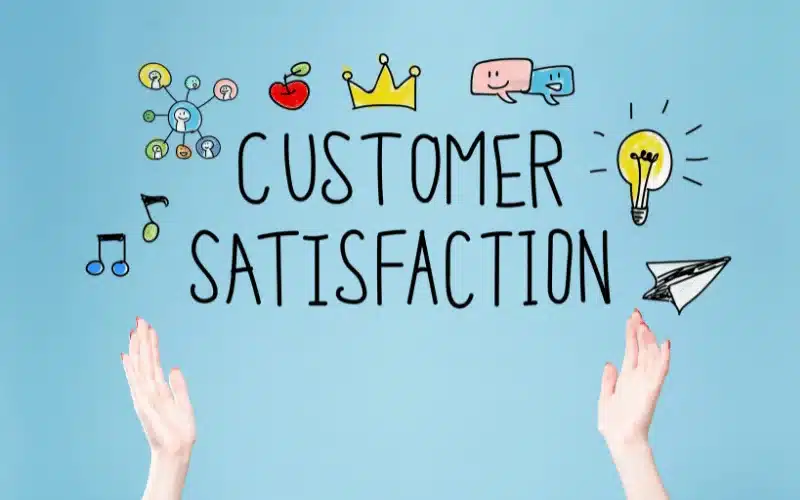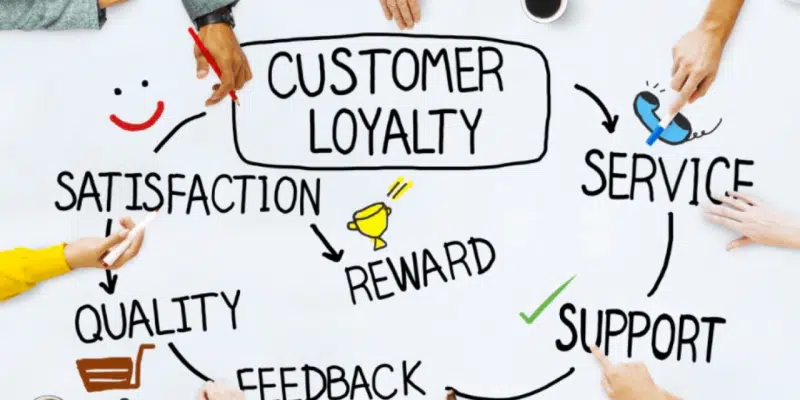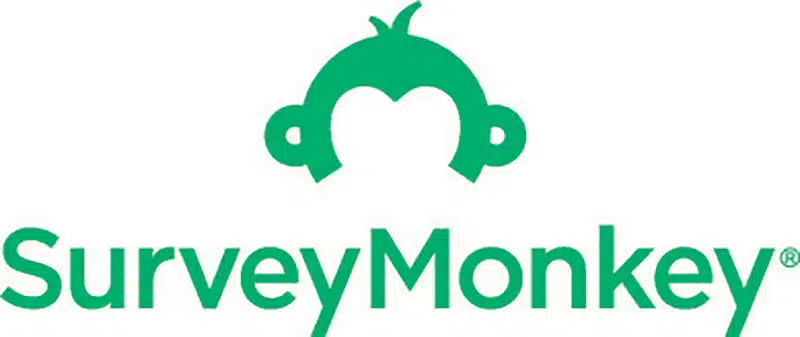As your company grows, team members may lose direct contact with customers, leading to a disconnect. This detachment can cause businesses to lose loyal customers and struggle to attract new ones, resulting in instability and declining revenue.
You certainly don’t want to live in that scenario, so let’s see what customer satisfaction is, understand the importance of customer satisfaction, how we can measure and improve it, and analyze customer satisfaction examples.
What is Customer Satisfaction?
Customer satisfaction is defined as the measurement your company takes to determine how happy your customers are with the products, services, and experiences received from your brand. Marketers use customer satisfaction surveys to evaluate if the company has met customers’ expectations.
Measuring customer satisfaction should be an ongoing process as your customers’ satisfaction levels can vary significantly from one experience to another, and from one journey stage to another. For example, if a newly acquired customer is thrilled with their first purchase experience, it doesn’t mean they can’t be let down by the following experience if your customer loyalty program isn’t as rewarding as a repeat, loyal customer deserves.
Implementing best practices, such as real-time feedback systems, periodic surveys, and customer interviews, can provide deeper insights into customer sentiments. This ongoing feedback loop ensures that you stay connected with your customers’ evolving needs and expectations, fostering a culture of continuous improvement.
Factors Influencing Customer Satisfaction
The customer satisfaction level is influenced by multiple factors, including:
- How they perceive the value brought by your products or services;
- How they perceive the quality of the products and services you deliver;
- How easy it is to receive what your brand has to offer;
- How well you’re communicating with them during a purchase and between two orders;
- How they evaluate your customer support team when they have questions or complaints about your products or services.
Customer needs and expectations change over time, so it’s your responsibility to take their pulse often, in the key moments of interaction with your brand. For example, you might provide an excellent online shopping experience, but if your delivery times are too long, customers might become unhappy. Similarly, even if your customer support team is well-trained, poor-quality products can lead to dissatisfaction and higher churn rates.
Why Is Customer Satisfaction Important?
Here are some key benefits of maintaining high customer satisfaction:
- Predict Future Behavior: Understanding customer satisfaction helps forecast customer actions and preferences. By analyzing satisfaction data, businesses can anticipate future purchasing behaviors and trends.
- Reduce Customer Churn: High satisfaction levels decrease the likelihood of customers leaving your brand. When customers are happy with their experiences, they are less likely to switch to competitors, resulting in lower churn rates and higher customer retention.
- Evaluate Business Health: Satisfaction metrics, along with Customer Lifetime Value, provide insights into your company’s health and growth potential. These metrics help assess whether your business is on the right track and if it can sustain long-term success.
- Boost Market Share: Satisfied customers are more likely to recommend your brand, aiding in acquiring new customers. Positive experiences lead to word-of-mouth referrals, which are a powerful tool for expanding your customer base and increasing market share.
- Identify Improvement Areas: Customer feedback highlights issues and areas needing improvement. Regularly collecting and analyzing feedback helps you pinpoint problems and make necessary adjustments to enhance the overall customer experience.
- Increase Revenue: Satisfied customers are more likely to make repeat purchases and explore additional products or services. This not only boosts sales but also increases the average customer lifetime value, contributing to higher overall revenue.
All companies have challenges in their effort to deliver the best experiences. However, what matters the most is how you act. You probably know that you can save a customer relationship even after an unsatisfying experience. Even what started as a negative experience can be transformed into a positive one with a clear customer support process in place.

How to Measure Customer Satisfaction?
All customer satisfaction metrics are captured using customer satisfaction surveys. In your journey towards achieving customer-centricity, customer satisfaction surveys are your most accurate guide if you see beyond numbers and manage to capture valuable insights. So, no matter what metrics you’re choosing, be sure you’re nailing the design of your survey.
The most popular customer satisfaction metrics are: Customer Satisfaction Score (CSAT), Customer Effort Score (CES), and Net Promoter Score (NPS).
Customer Satisfaction Score (CSAT)
Customer Satisfaction Score (CSAT) helps you measure the level of satisfaction after a customer’s most recent experience with your products or services. Measuring CSAT implies using a scale, usually a five-point scale, where 1 will be for “very unsatisfied” and 5 for “very satisfied.”
Customer Satisfaction Score formula:
CSAT% = (Number of satisfied customers (4 and 5 ratings) / Total number of responses) × 100
How to Calculate CSAT:
- Ask customers to rate their satisfaction on a scale from 1 to 5.
- Collect all the survey responses.
- Calculate the CSAT Percentage:
- Count the number of satisfied customers (those who rated 4 or 5).
- Divide this number by the total number of responses.
- Multiply by 100 to get the percentage.
For example, if you have 100 responses and 60 of them are ratings of 4 or 5, your CSAT score would be:
CSAT% = (60/100) × 100 = 60%
A low CSAT score, such as 20%, indicates that most of your customers are unsatisfied with your brand.
Customer Effort Score (CES)

Customer Effort Score (CES) helps you measure how easily a customer fulfilled the desired action during an interaction with your brand. Your customers can rate actions like placing a new order, using your products or services, returning some of the products, or receiving an answer to a question they addressed to customer success teams.
Customer Effort Score formula:
CES = Positive responses – Negative responses
How to Calculate CES:
- Ask customers to rate the ease of their interaction.
- Collect all the survey responses.
- Calculate the CES Score:
- Count the number of positive responses.
- Count the number of negative responses.
- Subtract the number of negative responses from the positive responses.
For example, if you have 100 responses with 70 positive and 20 negative, your CES score would be:
CES = 70 – 20 = 50
A low CES score indicates that customers find it difficult to interact with your brand, pointing to areas that need improvement.
Net Promoter Score (NPS)

Net Promoter Score (NPS) helps you measure how likely your customers are to recommend your brand, products, or services to their friends and family. NPS offers valuable insights into future customer behavior, being one of the most important performance indicators for your eCommerce store, along with customer lifetime value and profit margin.
Net Promoter Score Formula:
NPS = %Promoters – %Detractors
How to Calculate NPS:
- Ask customers to rate their likelihood of recommending your brand on a scale from 0 to 10.
- Collect all the survey responses.
- Classify Respondents:
- Promoters (score 9-10)
- Passives (score 7-8)
- Detractors (score 0-6)
- Calculate the NPS Score:
- Calculate the percentage of Promoters.
- Calculate the percentage of Detractors.
- Subtract the percentage of Detractors from the percentage of Promoters.
For example, if you have 100 responses with 50% Promoters and 20% Detractors, your NPS score would be:
NPS = 50% – 20% = 30
A low NPS score indicates that a significant portion of your customers are unlikely to recommend your brand, highlighting areas that need attention to improve customer loyalty.
> Learn all about NPS from our Ultimate NPS Guide.
Customer Satisfaction Examples
Understanding how leading companies excel in customer satisfaction can offer valuable insights for improving your own customer service strategies. Here are some customer satisfaction examples of of businesses that stand out in this area:
Netflix

Netflix is a prime example of a company that has disrupted an entire industry through exceptional customer experience. Netflix boasts an NPS score of 67, which is impressive in the SaaS category. From 21.5 million paid subscribers in 2011, Netflix grew to over 158 million paid memberships worldwide by 2019. Netflix boasts a customer loyalty score of 88%, according to Comparably.
Key to their success is personalization. Netflix’s recommendation algorithm suggests content based on user preferences, improving with each interaction. Features like ad-free streaming, offline viewing, and a broad content library cater to various customer needs. Their robust online presence and community engagement on social media also contribute to high customer satisfaction.
Bottom Line:
By offering personalized content, user-friendly features, and active engagement on social media, you can create a seamless and enjoyable experience that enhances customer satisfaction and loyalty.
Amazon

Amazon is recognized as one of the most customer-centric companies globally. Starting as an online bookstore, Amazon expanded to become a retail giant by focusing on removing friction from the buying process and offering exceptional value. In 2023, Amazon achieved a customer loyalty score of 89%.
Amazon’s success lies in its seamless online shopping experience, extensive product selection, and customer-friendly policies. Innovations like the Kindle, Alexa, and Amazon Go stores further demonstrate their commitment to improving customer convenience. Their Prime membership offers perks like fast delivery, exclusive deals, and access to various entertainment services.
Bottom Line:
By focusing on convenience, continuous innovation, and customer-friendly policies, you can drive high satisfaction and loyalty among your customers.
Nike

Nike, a leading athletic shoe brand, has achieved a customer satisfaction score of 84, surpassing the industry average of 83. Nike’s commitment to customer satisfaction is evident through its high-quality products, innovative designs, and excellent customer service.
Nike leverages customer feedback to continually improve its products and services. Their strong brand loyalty is also reinforced by personalized marketing strategies and community engagement through events and sponsorships.
Bottom Line:
By focusing on high-quality products, innovative designs, and excellent customer service, you can achieve high customer satisfaction and build strong brand loyalty.
How to Improve Customer Satisfaction?

Motivation varies, and so does customer satisfaction. Multiple factors influence how satisfied customers are with their interaction with your brand. Some are mainly interested in the quality of the products and willing to pay more for convenience. Others might be looking for more than quality products and want a sense of community and belonging.
The actions that you can take to improve customer satisfaction can be split into three categories:
Collect customer feedback regularly in key moments
Collecting feedback regularly allows you to be connected with how your customers perceive their experiences and make sure you’re keeping existing customers happy and loyal. An indispensable step in improving customer satisfaction is collecting feedback regularly in various moments of customer interaction.
For example, you want to collect feedback just after a customer has placed an order and shortly after receiving their order. If there’s a gap between these two key moments, you’ll know whether you’re having a marketing problem or there are some issues with a product or a service your customers purchased.
Be proactive and act in real time based on customer feedback
Collecting customer feedback without acting on valuable insights can be highly harmful to your business and can damage the customers’ trust in your brand. Put yourself in the customer’s shoes and think how you would feel if you complained about your latest experience without any reaction from the brand’s customer support team. Would you order again from that company? Probably not.
The great thing about constantly measuring customer satisfaction is that you can use customer input to trigger various automated flows depending on the feedback you receive and the customer type. For example, if you receive a low NPS from one of your top customers, you can notify your customer support team, and that customer becomes their top priority, allowing them to act in real time to fix the problem and maintain a high satisfaction level.
Transform customer feedback into customer experience improvements
The best customer experience optimization ideas might come directly from your customers. This is why the customer satisfaction surveys should include qualitative questions, too, allowing customers to signal problems about your website, delivery process, and level of quality, but also make suggestions about what could make their experiences more pleasant.
The feedback you receive from high-value and high-potential customers should weigh the most when prioritizing experience optimization activities. You want to please your top customers and make sure you make a good impression on newly acquired customers.
Customer Satisfaction Tools
A customer satisfaction tool offers you an effective way to collect feedback and measure how happy your customers are. It makes you more agile in identifying business opportunities and threats, why customers churn, and helps you make better decisions, with a customer-centric approach in mind.
Here are some top customer satisfaction tools to consider:
Omniconvert

Omniconvert provides comprehensive solutions for measuring and improving customer satisfaction. Its powerful features include advanced survey creation tools and a robust Net Promoter Score (NPS) system. Omniconvert’s NPS software allows you to measure customer loyalty and satisfaction both pre- and post-acquisition, providing insights at every stage of the customer journey. This helps you act in real time based on feedback, ensuring you can promptly address issues and improve customer experiences. For more information, you can visit our NPS software page.
SurveyMonkey

SurveyMonkey is a survey platform that allows businesses to create, distribute, and analyze surveys for gathering comprehensive feedback. It provides customizable survey templates and advanced analytics tools to interpret responses effectively. SurveyMonkey integrates with CRM systems and analytics platforms, making it suitable for conducting in-depth customer satisfaction surveys and deriving actionable insights.
SurveySparrow
![]()
SurveySparrow is a leading survey platform designed to transform small, mid-size, and large enterprises to create conversational, user-friendly surveys with ease. Launched with a vision to change the survey experience, SurveySparrow offers a variety of features that cater to different survey needs, from customer feedback and market research to employee engagement and event evaluations. With its intuitive interface, customizable templates, and advanced analytics, you will get a 40% higher survey completion rate. You can choose from the vast library of 1000+ templates and create surveys instantly.
Zoho CRM Plus

Zoho CRM Plus offers a suite of customer engagement tools for unified interactions across multiple channels. It includes AI-powered customer engagement, omnichannel communication capabilities, and analytics dashboards. Businesses can use Zoho CRM Plus to centralize customer interactions, track engagement metrics, and gain insights into customer behavior.
Tidio

Tidio is a live chat software combining email and website chat functionalities into a unified dashboard. It supports live chat, automated chatbots, and multi-channel communication for real-time customer interactions. Tidio integrates with email marketing and CRM platforms, improving customer support responsiveness and engagement across channels.
Qualtrics

Qualtrics is a customer experience management platform for capturing and analyzing feedback from various sources. It offers advanced survey design tools, multi-channel survey distribution, and analytics features. Qualtrics integrates with CRM systems and business intelligence tools to gather comprehensive feedback data and derive actionable insights for improving customer satisfaction.
Medallia Experience Cloud

Medallia Experience Cloud specializes in collecting and analyzing voice-of-the-customer (VoC) feedback across the customer journey. It features voice and text feedback collection, sentiment analysis, and integration with operational data sources. Businesses use Medallia to understand customer sentiments and behaviors, enhancing satisfaction levels across all touchpoints.
There are some aspects you should keep in mind when choosing a customer satisfaction tool:
- The tool should allow you to customize customer surveys;
- You should be able to evaluate satisfaction in various moments, on multiple channels, and from different angles;
- It should be easy to collect, store, and analyze customer responses;
- It should offer a clear view of how customer satisfaction evolved over time;
- The customer satisfaction score should be calculated automatically;
- It should allow you to trigger automated flows based on customer answers;
- It should easily integrate with other platforms your business uses.
By integrating your customer satisfaction tool with other platforms your online store uses, like email marketing or customer support platforms, you can enable real-time response, and other marketing automation flows that help you increase customer satisfaction.
> Find more about the features a customer satisfaction tool should include.
Wrap Up
The way you measure, monitor, and improve customer satisfaction directly impacts your business’s profitability. Make sure customer satisfaction measurement becomes an ongoing process in your company, and you’ll see how it benefits your business and customers alike.
Do you want to learn more about improving customer experiences and satisfaction? Good! We’ve prepared an advanced course for curious minds like yours. It’s called the Customer Value Optimization Course and is brought to you by world-renowned instructors. Discover who they are and what they teach!

Frequently asked questions about customer satisfaction
What are the 3 C’s of customer satisfaction?
According to McKinsey, the 3 C’s of customer satisfaction are Customer Journey Consistency, Emotional Consistency, and Communication Consistency. Customers are becoming more and more exigent, so you have to keep up with their needs and deliver excellent experiences at every interaction.
What are the 4 types of customer satisfaction?
There are four commonly recognized types of customer satisfaction:
Expected satisfaction, which is when a customer’s expectations are met; Delighted satisfaction, which is when a customer’s expectations are exceeded and they are pleasantly surprised;Measured satisfaction, which is when a customer’s expectations are met, but they are indifferent or neutral about the experience; Disappointed satisfaction, which is when a customer’s expectations are not met and they are dissatisfied with the experience.